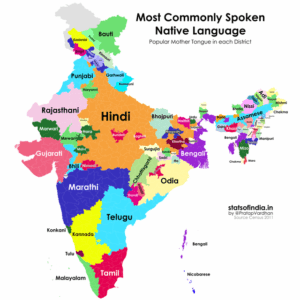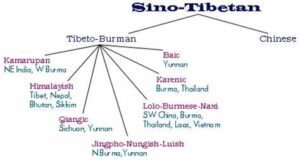Languages in India
With 22 official Languages in India and more than 1,600 dialects, India is a linguistic and cultural mosaic where each is intricately entwined with the country’s rich artistic and cultural heritage. Ancient Indian language Sanskrit has shaped spiritual traditions and philosophies through its influence on classical Indian music, dance, and literature.

Through literature, film, and folk arts, Hindi, the most widely spoken language in India, reflects the rich diversity of North Indian culture. Two of the oldest Dravidian languages, Tamil and Telugu, are home to vibrant classical literatures and artistic expressions such as Kuchipudi and Bharatanatyam.
In Eastern India, Bengali, the Languages in India of famed poet Rabindranath Tagore, is a center for literature, music, and the arts. Prominent South Indian languages Malayalam and Kannada are renowned for their elaborate dance forms, classical poetry, and temple architecture. In India, every language functions as
Human writing has reflected culture, lifestyle, society and contemporary society throughout history. In the process, each culture developed its own language and created a vast literary base
This wide base of literature gives us a glimpse of the evolution of each language and culture over the centuries
Human writing has reflected culture, lifestyle, society and contemporary society throughout history. In the process, each culture developed its own Languages in India and created a vast literary base
This wide base of literature gives us a glimpse of the evolution of each Languages in India and culture over the centuries
Diverse dialects can arise from a particular language. The languages spoken in different regions of the India belong to the family of many languages, most of which belong to the Indo-Aryan group of languages. It is the Indo-Aryan group originated from the Indo-European family. Some language groups are the indigenous groups of the Indian subcontinent.
Classification of Indian Languages
Languages in India are classified into the following major sub-groups:
- Indian Aryan group
- Dravidian group
- Northern Group
- Central Group
- Southern Group
- Sino-Tibetan Group
- Austic group
- others
Indo-Aryan group of languages
It is the branch of the larger Hindi European family that came into India with the arrival of the Aryans It is the largest language group in the India and about 74% of Indians speak Languages in India belonging to this group.
Ancient Indian Aryan Group
From this, the development of groups took place around 1500 BC and from this the culture was born. Sanskrit can be called the mother of many Indian languages, it is the oldest language of our country, it is one of the 22 languages listed in the constitution.
Ancient Culture as a Carrier of Indian Culture
The development of Sanskrit grammar began from the time of Pani in 700 BC of his book Ashtadhyayi, this book is the oldest book on Sanskrit grammar. Some of the literature related to Mahayana and Hinayana sect is also in Sanskrit language.
The book Mahavastu of the Hinayana sect is a treasure trove of stories The most sacred Mahayana grant Lalita Vistara and the ghost character of Ashvaghosa were also written in Sanskrit language. The only culture is a language that transcends the barriers of region and boundaries.
There is no such part in India from north to south and east to west. For which Sanskrit language has not contributed or which has not been influenced by Sanskrit language. The cultural and Pranjal form developed between 300 BCE and 200 BCE.
It was the processed version of the Vedic culture. The first evidence of the use of culture can be found in the inscription of Rudradaman at Junagadh in present-day southern Gujarat the use of culture in poetry is known to be known from the Gupta period, it is a period of purely Sudha literary composition which is evident in the works of epics and khandakavya,
in the field of Sanskrit literature, this period is known as the unique composition period, due to which various types of literary works were composed during this reign.
Central Indian Aryan group of languages
The development period of this subgroup should be between 600 and 1000 BC This began with the development of natural language, which means nature is understood to be intuitive, indicating that there is no rigid rule for its use.
The common dialect is natural, in a broad cohesive way, all the languages of the Central Indo-Aryan group are included the origin of many languages like Ardha Magadhi, Pali, Apabhramsa etc. is found in nature, nature was related to the livelihood of the common people, while on the other hand Sanskrit was conservative.
The script was developed relatively later in Prakrit language than in culture. Prakrit and semi-Magadi launguage were used in the Jain Agams. The period of transition from one language to another was mantra and could not be divided into strict chronological periods.
Nature includes
Pali It was widely spoken in Magadha. This Isha influence was popular between the 5th to 1st centuries. It is closely related to culture and was written in Brahmari script. The Tripitaka of Buddhism was written in Pali. It served as the common language of Theravada Buddhism.
Magadhi Prakriti or Ardhamagadhi
These are the most important types of nature Sanskrit, and its literary use increased after the decline of Pali Buddha and Mahavira spoke in Ardhamagadhi. Many Jain texts and Ashoka’s edicts were also written in Artha Magadi, Eastern India languages i.e.
Bengali, Assamese, Oriya, Maithili, Bhojpuri etc. Shourseni was widely used to write plays in medieval India. It is the Satavahana dynasty was the official language It was the official language of many plays written in it. Illu is the ancient form of modern Sinhala language of Sri Lanka Paisachi it is also called ghost language The ancient eoic paisachi bhasha called bruhatkatha of Gunadhya.
Apabhramsa
Six seven centuries Apabhramsa had developed into an inclusive one that encompasses all dialects other than culture or even natural.
It refers to the transition of the languages of the modern Indo-Aryan groups of the Middle East Gradually it became a literary language and was used in the writing of many texts, Kathawadi, the seventh century Satak Apabhramsa had developed its identity, this can be highlighted from the fact that in the sixth or seventh century AD, the famous poets of Kashmir.
Bhama, the famous poet of Kashmir, divided poetry into Sanskriti, Prakriti and Apabhramsa, as well as Dandi, the ancient litterateur of culture, also said. Scholar by many Jain Munis wrote extensively in Apabhramsa and preserved its major texts, and the author is Pushpadanta’s Mahapuran of Dhanapala Bhavisayattakha ets.
Modern Indian Aryan Group
The languages belonging to this group are Hindi Assamese, Bengali, Gujarati, Marathi, Punjabi, Rajasthani, Sindhi, Oriya, Urdu, etc. The languages of this sub-varak developed after 1000 BC. These languages are mainly spoken in the northern, western and eastern parts of India.
Dravidian Group
This group includes Languages in India spoken mainly in the southern parts of India. About 25% of the Indian population is included in this group. The Dravidian Languages in India has 21 Dravidian languages. They can also be broadly grouped into three groups: the Northern Group, the Central Group and the Southern Group.
Northern Group
These include three languages i.e. Brahui, Malto and Krugh, Brahui is spoken in Balochistan, Malto, the tribal areas of Bengal and Odisha, while Krukh, Bengal, Odisha, Bihar and Madhya Pradesh are spoken
Central Group
It consists of 11 languages i.e. Gondi, Khond, Kui Manda, Gadba, Kolami, lack of pago Telugu Only Telugu became a civilized Languages in India and is spoken in the states of Andhra Pradesh and Telangana.
Southern Group
Seven Languages in India belong to this group, these are Kannada, Tamil, Malayalam, Tulu, Kodagu, Toda and Kota, Tamil is the oldest of them. Among these 21 languages, the four major languages of the Dravidian group are: Telugu, Tamil, Kannada, Malayalam.
Sino-Tibetan Group
The Languages in India of this group belong to the Mongolian family, Mongolian is found in the entire Himalayas, northern Bihar, northern Bengal and the northeastern borders of the country, these languages are considered to be older than the Indo-Aryan languages.

The Chinese Tibetan group is divided into two groups: Tibetan Burman, Saiyami Chinese.
Austrian
The Languages in India of this group belong to the Austro-Asiatic sub-family which includes the Munda and Kol groups of languages and are spoken in Middle Eastern and Northeastern India, some of them also belong to the Maun Khemer group such as Khali and Nicobarese
They were referred to as Nishad in ancient culture literary. The most important Languages in India under this group is Santhali, spoken by the Santhal tribals of Jharkhand, Bihar and Bengal. All medicinal in Indian territory except Khasi and Santhali.
Other
These groups include many Dravidian tribal languages such as Gondi, Oraon, Praji which are very different and cannot be classified into appropriate mention groups.
Conclusion
With more than 1,600 dialects and 22 officially recognized Languages in India, India is home to a rich linguistic diversity. Its art and culture are intricately entwined with this diversity, as each language reflects a distinct regional heritage. Sanskrit and Tamil, two ancient languages, have historically influenced Indian philosophy, literature, and religion. They have also had an impact on dance, music, and temple architecture.

Languages in India Languages like Hindi, Bengali, Telugu, and Kannada enhance India’s cultural mosaic in the modern era by supporting thriving theater, cinema, and literary traditions. Oral traditions, folk art, and regional crafts are all greatly enhanced by the use of local languages in India. For example, the multilingual retellings of ancient epics such as the Ramayana and Mahabharata continue to inspire paintings, plays, and festivals all over the nation.
